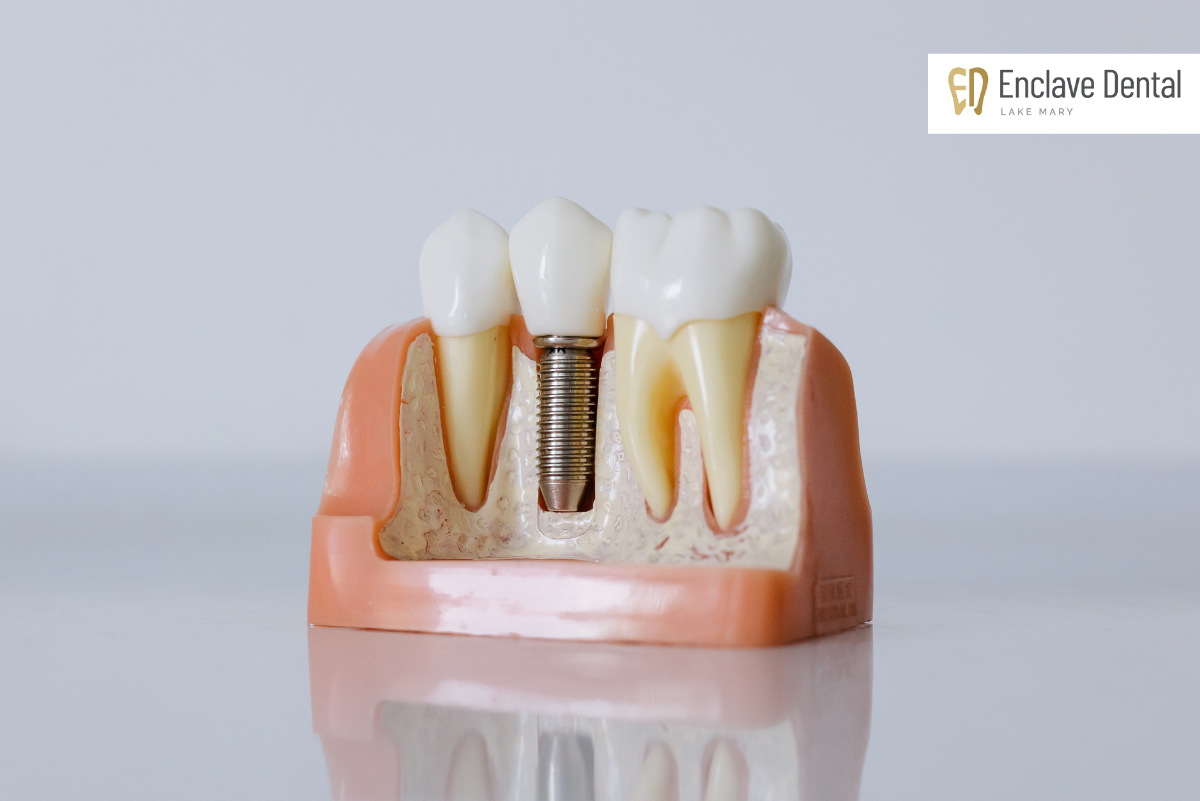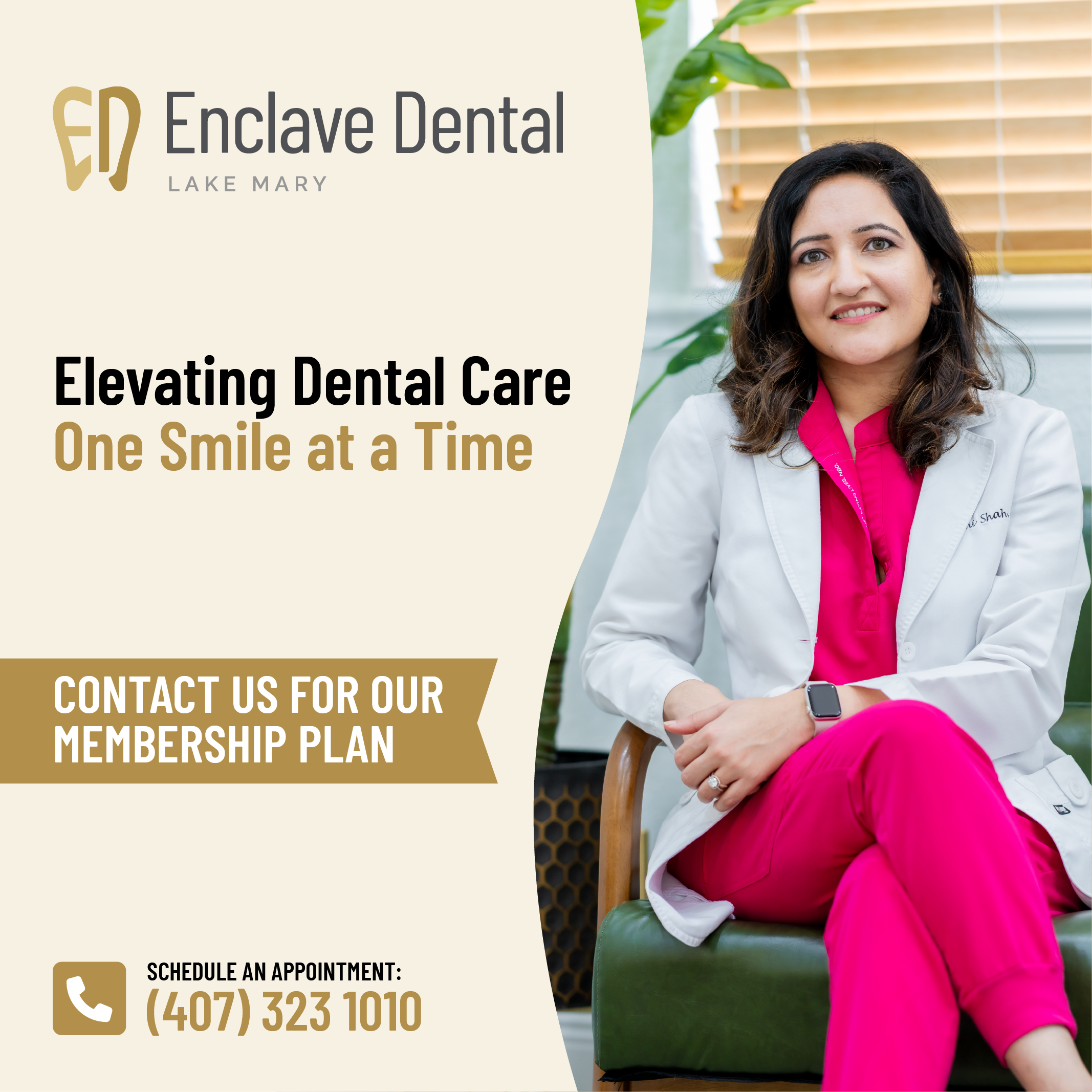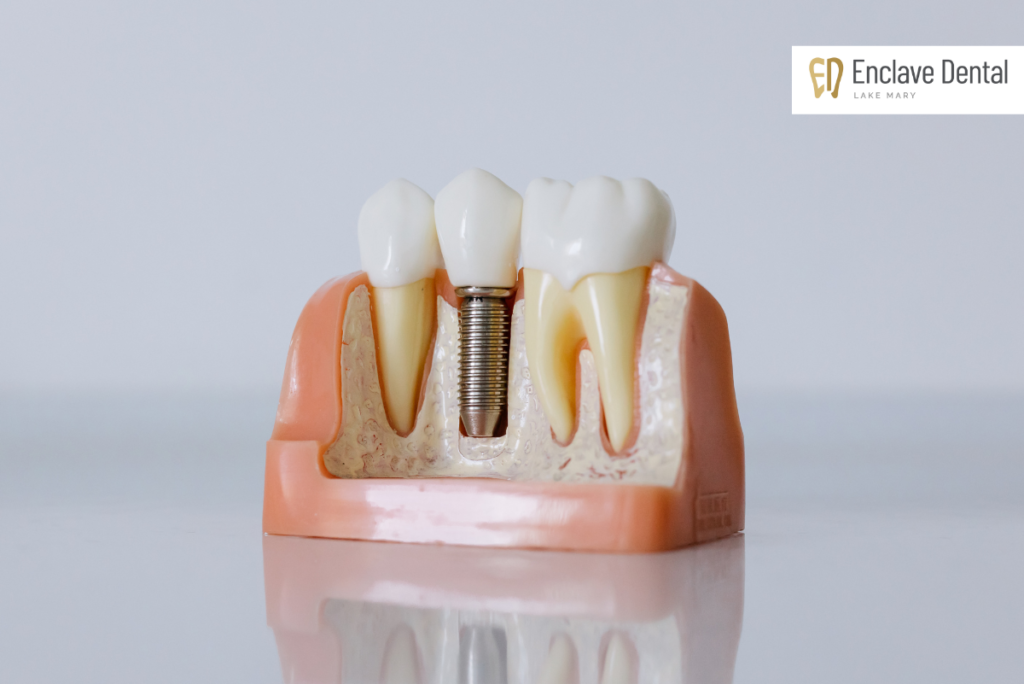At Enclave Dental in Lake Mary, FL, we focus on lasting smiles by combining advanced dental implant solutions with excellent gum health. Dental implants are titanium posts that replace missing tooth roots, allowing custom crowns to mimic natural teeth in appearance and function. These restorations are anchored in the jawbone, stimulating bone and preserving facial structure.
This guide is designed for local patients in Lake Mary, Florida, and emphasizes finding a qualified dentist in Lake Mary FL to achieve a healthy, confident smile.
Understanding Dental Implants and Gum Health
Dental implants are artificial tooth roots, typically made of biocompatible titanium. The implant consists of three parts: the implant post (screw), an abutment (connector), and a porcelain crown. When a tooth is lost, implants replace the root by fusing with the jawbone (osseointegration).
Healthy gums and sufficient bone are prerequisites: before placing implants, your dentist will check and treat gum disease or bone loss. Good periodontal (gum) health is critical because inflamed or receding gums can lead to peri-implantitis (implant infection) and implant failure. By choosing an experienced dentist in Lake Mary FL, patients ensure that gum health is optimized before and after implant surgery for long-term success.
Components of a Dental Implant
- Implant Post (Fixture): A titanium screw placed into the jawbone, acting like a natural tooth root.
- Abutment: A connector piece attaches to the implant post and holds the crown.
- Crown (Restoration): A custom-made prosthetic tooth (often porcelain) that looks and functions like a natural tooth.
Together, these parts create a secure, natural-looking replacement. The titanium post fuses with bone, providing stability; the abutment provides support; and the crown restores appearance and chewing function.
Benefits of Dental Implants
Dental implants offer many advantages over traditional bridges or dentures. These benefits include:
Natural Appearance and Feel: Implants look and feel like real teeth. The crown is color-matched to your teeth, blending seamlessly with your smile. Patients report high satisfaction with the aesthetics of implants.
Durability and Long Lifespan: Titanium implants are firm and long-lasting. Studies show implant success rates above 97% at 10 years. Unlike dentures, implants do not slip or wear out quickly. With proper care, they can last decades.
Prevents Bone Loss: When a tooth is lost, the jawbone gradually resorbs. Implants act like real roots, stimulating the bone. Research confirms that implants slow down bone loss, preserving facial structure and jaw health.
Stable Chewing and Speech: Because implants are anchored securely, they function like natural teeth. They allow full chewing power without slipping, and help maintain normal speech. In contrast, removable dentures may shift and affect speech.
Protects Adjacent Teeth: Unlike bridges that require grinding down neighboring teeth, implants stand alone and do not compromise adjacent teeth. This helps keep your other teeth healthy and aligned.
Improved Confidence: A complete, stable smile boosts self-esteem. Many patients feel more confident eating, speaking, and smiling after implants. Their natural look and secure fit help patients feel at ease in social situations.
Dental implants replace missing teeth with the next-best thing to natural teeth, combining strength, durability, and aesthetics.
Step-by-Step Dental Implant Procedure
Getting a dental implant is a planned process involving multiple steps. The timeline can span several months, especially if bone grafting is needed. A typical procedure sequence is:
Consultation and Treatment Planning: Your dentist (often a periodontist or oral surgeon) evaluates your oral health. X-rays or 3D scans (CBCT) assess bone density and nerve location. A personalized plan is made, considering how many teeth are missing and overall health.
Preparation (Tooth Extraction and Bone Graft): If a damaged or decayed tooth is present, it’s removed. If the jawbone is insufficient, a bone graft is placed to strengthen the site. This may require several months of healing for the graft to integrate.
Implant Placement (Surgery): In a minor surgical procedure, the implant post is inserted into the jawbone. Anesthesia (local or sedation) keeps you comfortable. The post is positioned precisely, often using surgical guides. The implant fuses with the bone over the next 3–6 months (osseointegration).
Abutment and Crown Placement: Once healed, a small connector (abutment) is attached to the implant. A custom crown is then secured on top. The crown matches your other teeth in color, shape, and size.
Each phase is crucial: rushing can compromise success, and skipping preparatory steps like treating gum disease can cause complications. Short, temporary crowns can often be placed during healing for aesthetics. Regular follow-ups ensure everything is on track.
By understanding the process, Lake Mary, FL, patients can prepare for each step. We will guide you through consultation, scheduling, and recovery care.
Quick Tips: (Note: These quick tips can be highlighted in a box)
- Each procedure visit usually takes 1-2 hours, often in an outpatient setting.
- Total treatment time: typically several months (often 5–8 months) from start to finish.
- Most people resume normal activities within a few days. Minor swelling or discomfort is normal after surgery, but it is manageable with pain medication and ice.
- Smoking or uncontrolled diabetes can slow healing; discuss health factors with your dentist.
Types of Dental Implants
Dentistry offers options to replace one tooth or many. The main categories are:
Single-Tooth Implants
This is the classic implant scenario: one missing tooth is replaced with one implant and crown. A single implant restores the tooth’s function and appearance without affecting adjacent teeth. It involves the three components (post, abutment, crown) described earlier.
Multiple Tooth Implants
When several teeth in a row are missing, implants can replace them with a bridge or individual crowns. For example, two implants can support a three-tooth bridge, reducing the need for multiple implants. This can be more cost-effective and still preserve bone. The dentist will plan the number of implants based on jaw health, spacing, and bite load.
Implant-Supported Dentures
Implant-supported dentures (overdentures) offer a stable solution for patients missing most or all teeth. Instead of resting on the gums like conventional dentures, these prosthetics “snap” or bolt onto implants anchored in the jaw.
- Removable Overdentures: A bar or snaps connect to implants, allowing the denture to be cleaned.
- Fixed Hybrid Dentures: A full arch of teeth fixed on a metal framework that is screwed into 4–6 implants, usually not removable by the patient.
Implant-supported dentures anchor directly to your jawbone using dental implants, offering more stability for chewing and speaking than traditional dentures. This prevents the slippage and bone loss seen with non-implant dentures, so patients feel more secure when eating and talking. Many people find implant dentures more comfortable and confident than old-style dentures.
The Importance of Gum Health
Healthy gums (periodontal health) are the foundation for any dental implant. Gum disease (gingivitis or periodontitis) must be treated before implant placement. Inflammation or infection around implants (peri-implant mucositis or peri-implantitis) can cause bone loss and implant failure.
Pre-implant Assessment: A qualified dentist will check gum pockets, inflammation, and bone levels. Any active gum disease requires professional cleaning and possibly periodontal treatment first.
Peri-implantitis Prevention: Peri-implantitis is akin to gum disease around implants. Poor oral hygiene allows plaque to build up at the gumline, leading to inflammation. In severe cases, it can cause the implant to loosen.
Signs to Watch: Red, swollen, or bleeding gums around an implant are warning signs. Prompt dental check-ups can catch issues early.
Proper oral hygiene dramatically lowers these risks. Brush twice daily with a soft brush, floss, or use interdental cleaners around implant teeth, and consider an antimicrobial rinse if recommended. Specialized tools like implant-specific floss and water flossers can clean hard-to-reach areas.
Your dentist in Lake Mary FL, will stress gum health because the implant’s success depends on the gum-to-implant seal and supporting bone. Keeping your gums healthy protects your investment and allows you to enjoy your new teeth longer.
Long-Term Care for Dental Implants
After your implant is placed, ongoing care ensures it lasts. Implants cannot decay like natural teeth, but the surrounding tissue can become inflamed. Follow these guidelines:
- Daily Oral Hygiene: Brush all teeth (including implants) twice daily. Use a low-abrasive toothpaste. Daily use of implant-safe floss or interproximal brushes to remove plaque around the implant crown and abutment.
- Regular Dental Check-ups: Visit your dentist for professional cleanings and exams at least twice a year (or as recommended). Even if you have an implant, the dentist will check for gum inflammation, bone changes, or prosthetic wear. Early detection of any issue (like plaque buildup or tiny cracks) can prevent bigger problems.
- Lifestyle Habits: Avoid smoking and limit alcohol, as these can impair healing and gum health. Eat a balanced diet of calcium and vitamin D to support bone health. If you grind your teeth at night, use a night guard. Heavy clenching can stress implants.
- Monitor Implant Health: Keep an eye on how your implants feel. Occasional sensitivity is normal right after placement, but persistent pain, mobility, or gum changes should prompt a dental visit.
Research indicates that consistent implant maintenance reduces the risk of peri-implant disease and failure. Proactively caring for your mouth helps ensure your implant remains strong and functional for years.
Finding a Skilled Dentist in Lake Mary FL
Choosing the right provider is crucial. Look for a qualified dentist in Lake Mary FL, with implant experience. Consider these factors:
Specialized Training: Many dentists pursue extra training in implantology. Specialists like prosthodontists, periodontists, or oral surgeons are often well-versed in implants and gum care. You may see credentials like AAID Fellow or ABOI Diplomate. The American Academy of Implant Dentistry (AAID) even provides a searchable directory of implant dentists.
Experience and Technology: Ask how many implant cases the dentist has performed. Inquire about their technologies (digital imaging, guided surgery) to plan precise implant placement. Advanced equipment and local anesthesia/sedation options can improve safety and comfort.
Patient Reviews and Consultation: Read local reviews. During a consult, note whether the dentist explains things clearly, addresses your gum health concerns, and provides customized options. A good dentist will evaluate your gums and bone carefully and discuss maintenance.
Comprehensive Care: Ideally, your Lake Mary dentist or their team handles all aspects (extraction, graft, surgery, restoration) or partners closely with specialists. This continuity of care can make the process smoother.
A caring local team that follows up with you post-surgery will help your implant journey go smoothly. Don’t hesitate to ask your dentist in Lake Mary FL, about their implant success rates and how they protect gum health in every case.
Your Path to a Healthy Smile with Enclave Dental!
Dental implants can transform how Lake Mary patients smile, speak, and eat — but their success depends on expert care and healthy gums. Choosing a qualified dentist in Lake Mary FL, who emphasizes gum health, ensures that your implants have the best chance of lasting a lifetime. Remember that diligent oral hygiene, regular dental visits, and avoiding harmful habits will keep your gums healthy and your implants strong.
Whether you need a single implant, a bridge, or implant-supported dentures, modern dentistry offers solutions that look natural and perform reliably. Take the first step by scheduling a consultation with our experienced Lake Mary dentist, Dr. Shachi Shah. Our team at Enclave Dental is ready to guide you through the process, combining high-tech implant procedures with personalized gum care for a confident, lasting smile.
Frequently Asked Questions (FAQs)
What is the dental implant process like at Enclave Dental?
The process involves several steps: initial consultation, placement of the implant post, healing and integration with the bone (a process called osseointegration), and finally attaching the custom-made crown or restoration. The entire process can take a few months for full integration and healing.
Is the implant procedure painful?
Most patients report minimal discomfort during and after the procedure. Local anesthesia is used during surgery, and post-operative pain is typically manageable with over-the-counter medications. Dr. Shah will guide you through the entire recovery process.
What is the cost of dental implants?
The cost varies depending on the number of implants and additional procedures required (like bone grafting). At Enclave Dental, we’ll provide a personalized treatment plan and discuss financing options to make your care as accessible as possible.
Do dental implants require special care?
No special care is needed beyond regular oral hygiene. Brush and floss daily, avoid tobacco use, and attend regular dental checkups to keep your implants in excellent shape.
How do I schedule a consultation for dental implants?
Simply contact Enclave Dental to schedule an appointment. Dr. Shah will perform a comprehensive evaluation and help you explore whether dental implants are the best solution for restoring your smile.

Dr. Shachi Shah a Lake Mary resident and the owner dentist at Enclave Dental, brings a wealth of expertise and a compassionate approach to every patient interaction. With years of experience in both general and cosmetic dentistry,






